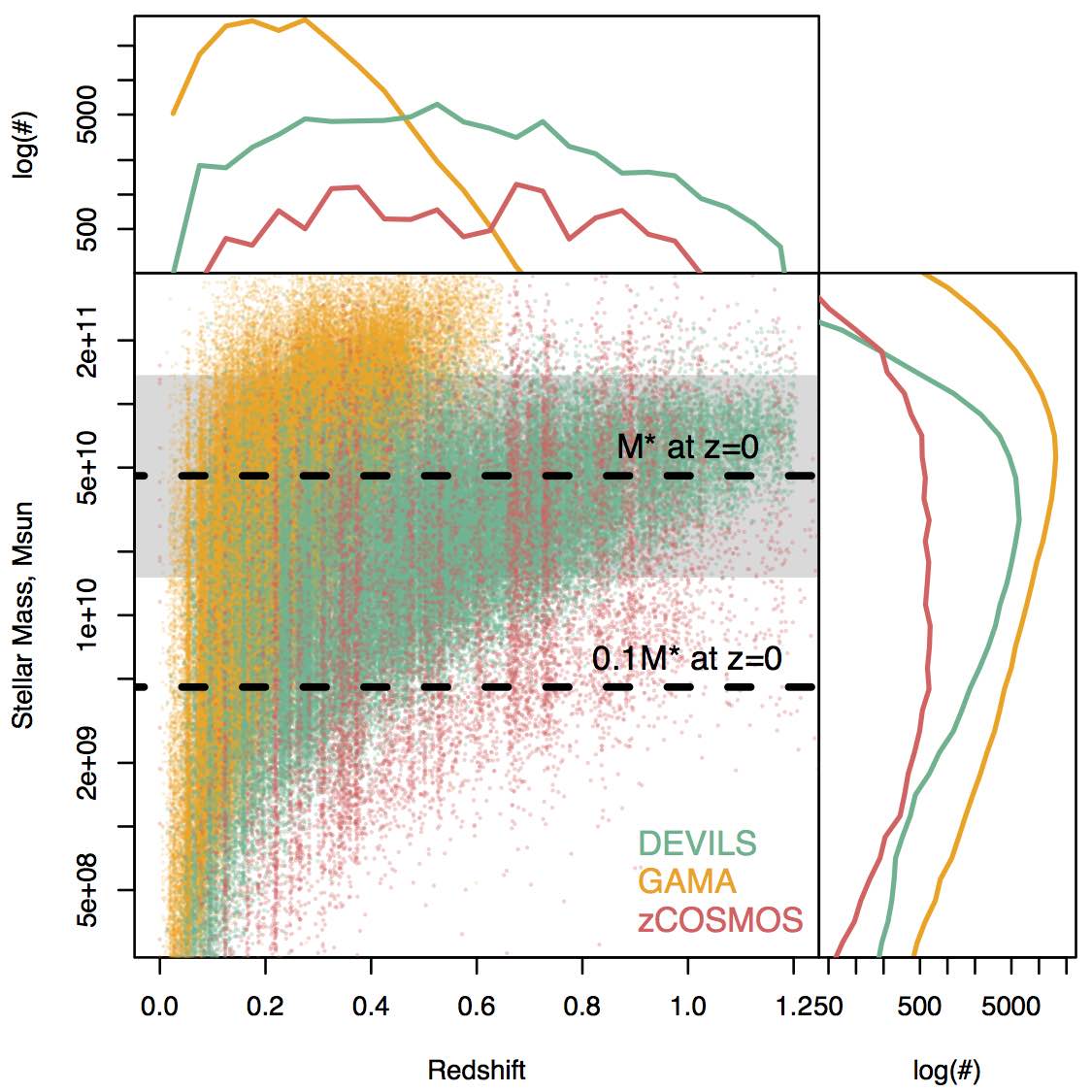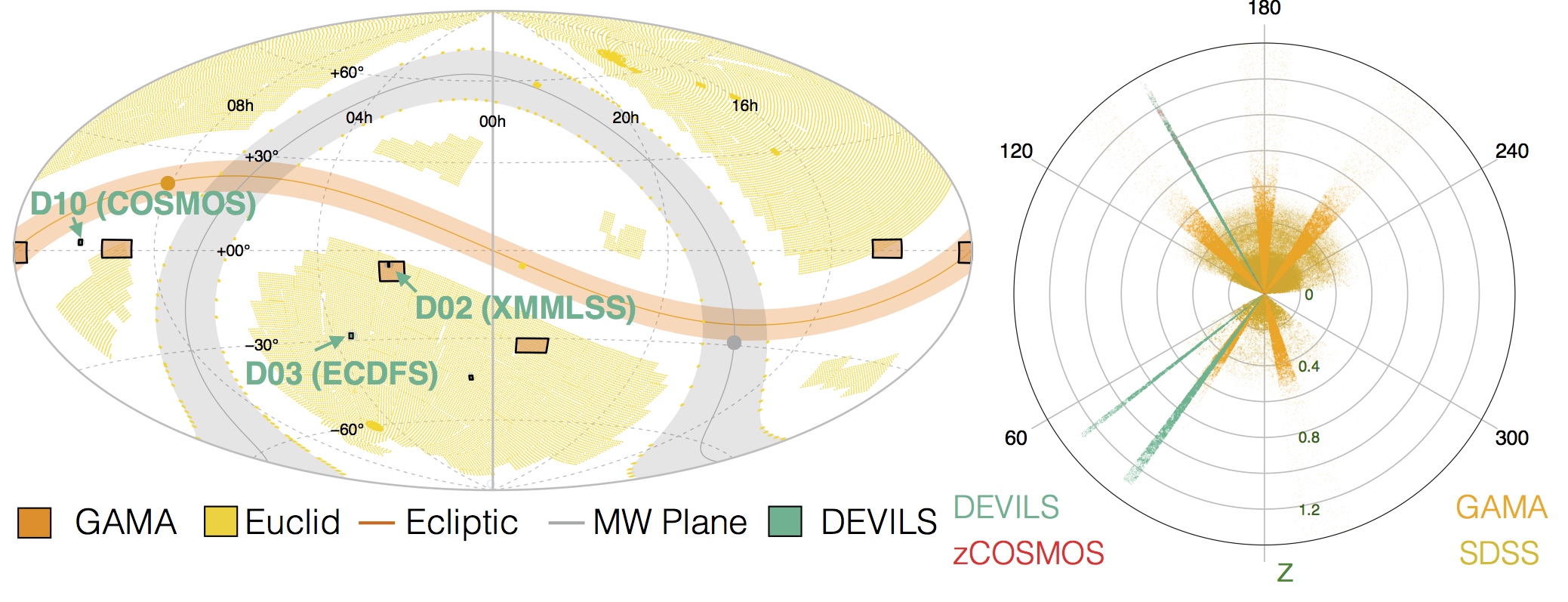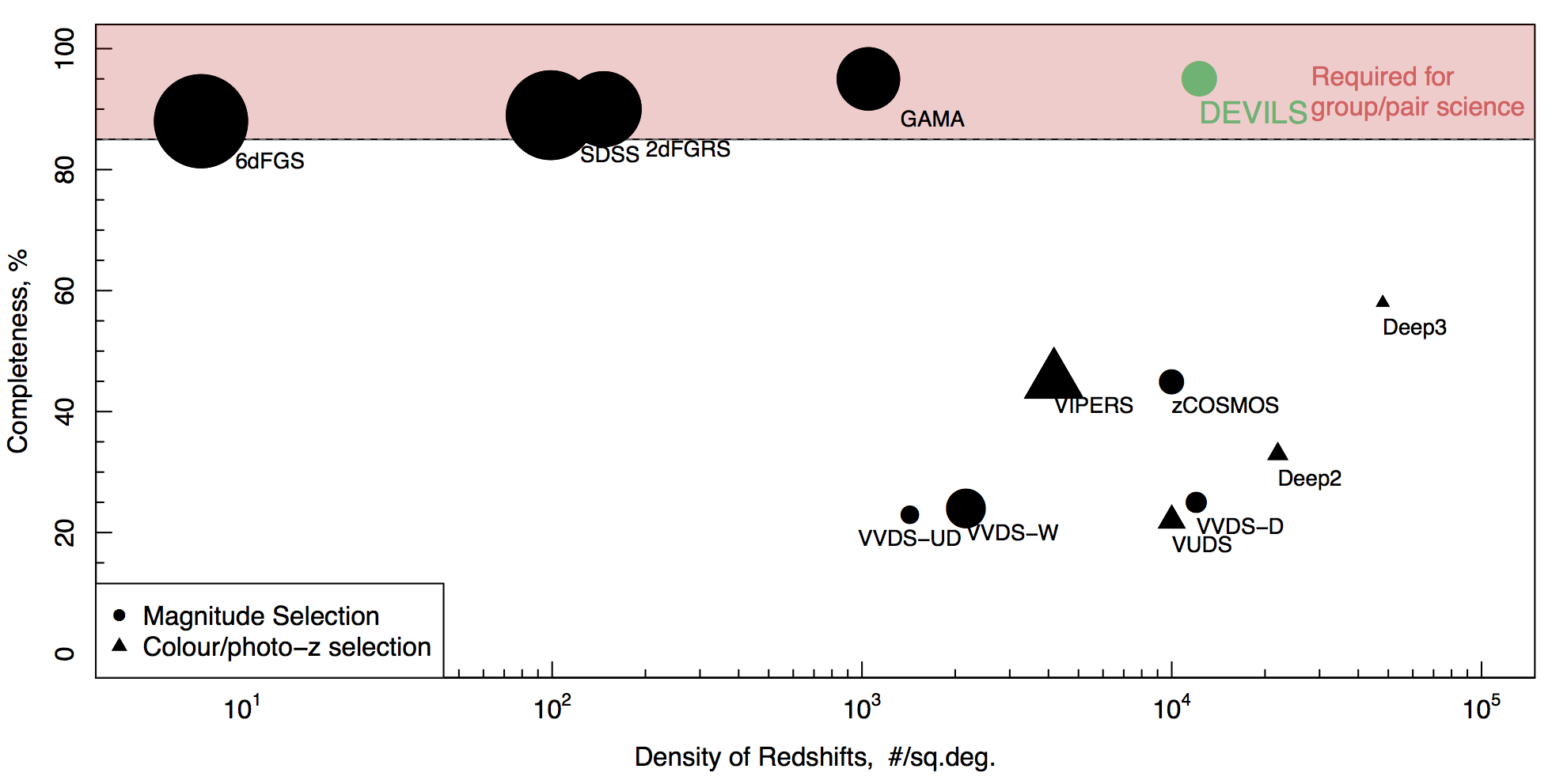
Depth & Target Selection
To characterise sub-Mpc structure to z < 0.8, DEVILS will reach the lowest possible stellar mass galaxies, while remaining within the constraints of the AAT+AAOmega. To meet our science goal the DEVILS selection depth is designed to: i) identify multiplicity >3, >1013M⊙ groups to z = 0.7 , ii) measure the galaxy stellar mass function to M∗z=0 at z = 1 (Fig 1), and iii) measure the major merger rate for M∗z=0 galaxies to z = 0.7 by identifying all systems at < 3:1 mass ratio (> 0.3 M∗z=0, grey band Fig 1). A Y < 21.2 selection will meet these constraints. DEVILS will use the Y -band as we wish to i) be close to a single band measurement of stellar mass (NIR), ii) select in flux at rest-frame > 4000 ̊A to z ∼ 1 (> 8000 ̊A observed), iii) select from a single instrument/facility (VISTA has the only contiguous observations across our fields) and iv) meeting previous conditions, be as close to the observing wavelength of AAOmega as possible. The VISTA Y -band at ∼ 1 μm meets all of these criteria, and is the deepest band in VIDEO (5σ point source depth is Y ∼ 25). Observations with the AAT will cover ∼ 3700-8800 ̊A at R ∼ 1000-1600, allowing identification of key spectral features across our redshift range; [OII] and Ca H & K to z ∼ 1.
Area & Field Selection
The robustness of any evolution and structure survey increases with volume. Thus, we wish to maximise area, while once again remaining within observing constraints and retaining maximum legacy value. We require robust number statistics for both structure tracers (groups/pairs) and individual galaxies. Given our depth and key science goals we require ~6deg2 to both parametrise the evolution of the high mass end of the halo mass function and determine the effect of environment on galaxy evolution at intermediate redshifts. To maximise legacy science with auxiliary data, DEVILS will target deep, well studied extragalactic fields. There are a number of optimal 2dF (∼ 2-3 deg2) deep fields with diverse multi-wavelength data accessible from the AAT. We have selected three (Fig 2, Table 1) which have the most extensive existing legacy data and are soon to be targeted with the next generation of instruments: each field has/will have: deep x-ray (XMM, Chandra), optical (HSC, DES, LSST deep-drill), NIR (VIDEO, UltraVISTA), MIR (Spitzer), FIR (Herschel) imaging, high resolution imaging (Euclid, HST), and radio imaging/spectra (ATCA, MeerKAT, JVLA), as well as existing spectroscopy (e.g. OzDES, zCOSMOS…). As such, these are key legacy fields which would benefit immensely from a highly complete spectroscopic survey – a unique database for the astronomy community. We opt to target a 2 × 1.5 deg2 contiguous region in XMM-LSS to maximise legacy science with x-ray observations of DEVILS groups and large-scale structure. We will however, prioritise a single 1.5deg2 region in XMM-LSS before observing the second, to ensure we obtain the completeness for our science goals.

Table 1: Target Fields
Name |
Common Name |
RA
|
Dec
|
RA
|
Dec
|
Observable (AAT) |
Input Band |
Input Depth |
Input Survey |
|---|---|---|---|---|---|---|---|---|---|
| D02 | XMM-LSS | 35.4975 | -4.825 | 02:21:59 | -04:49:30 | Sept-Dec | VISTA-Y | Y<21.2 | VIDEO |
| D03 | ECDFS | 53.65 | -28.1 | 03:34:36 | -28:06:00 | Sept-Jan | VISTA-Y | Y<21.2 | VIDEO |
| D10 | COSMOS | 150.1 | 2.1 | 10:00:24 | 02:06:00 | Jan-April | VISTA-Y | Y<21.2 | UltraVISTA |
Comparison To Other Surveys
In order to probe the evolution of galaxies, their environment and the dark matter halos in which they reside, we require highly complete samples. While this has been achieved in the relatively local Universe (SDSS, GAMA, etc) until now, deep higher redshift surveys have suffered from low completeness which are inadequate for galaxy group/pair science. Fig 3 displays a comparison between DEVILS and existing surveys. The only surveys at comparable redshifts and number densities have complex selection functions and/or very low completeness (VIPERS, DEEP2, VVDS). The current state of the art survey for galaxy evolution at these epochs (zCOSMOS- bright) covers much less area, has under half an order of magnitude fewer sources and only ∼ 50 % completeness. None of the key science goals of DEVILS can be undertaken with these surveys.


